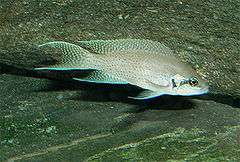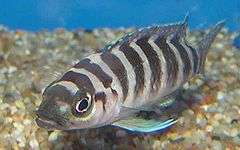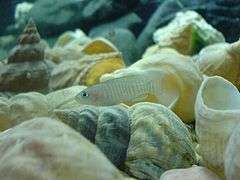Neolamprologus
| Neolamprologus | |
|---|---|
 | |
| Neolamprologus brichardi from Lake Tanganyika. | |
| Scientific classification | |
| Kingdom: | Animalia |
| Phylum: | Chordata |
| Class: | Actinopterygii |
| Order: | Perciformes |
| Family: | Cichlidae |
| Tribe: | Lamprologini |
| Genus: | Neolamprologus Colombé & Allgayer, 1985 |
| Type species | |
| Lamprologus tetracanthus Boulenger, 1899 | |
Neolamprologus is a genus of cichlids endemic to eastern Africa with all but one species, Neolamprologus devosi from the Malagarasi River, occurring in Lake Tanganyika. It is the largest genus of cichlids in Lake Tanganyika and also the largest genus in the tribe Lamprologini, which includes Altolamprologus, Chalinochromis, Julidochromis, Lamprologus, Lepidiolamprologus, Telmatochromis and Variabilichromis. The latter is a monotypic genus doubtfully distinct from Neolamprologus.
It is already known for some time that according to mtDNA sequence analysis, this genus is very probably polyphyletic. It is likely that it will be revised eventually; if Variabilichromis is split off, at least some of the more ancient lineages currently polaced in Neolamprologus are probably worthy of separation also. However, the morphological similarity and numerous undescribed species do not make analyses easier, and as with many cichlids, recent speciation and abundant hybridization seriously confound molecular studies to the point where single-gene studies or those using only mtDNA or nDNA are essentially worthless for resolving Lamprologini phylogeny.[1]
While lineages are clearly different in their morphology, habits and ecology, gene flow between genera and species is common enough due to extremely low postzygotic isolation. Males of Neolamprologus apparently have always readily and successfully mated with females of other Lamprologini they found ready to spawn: mtDNA lineages similar to other Lamprologini genera are widely encountered in species placed in Neolamprologus. And not only do such hybrids seem to be fertile at least to a limited extent in many cases, new species often appear to originate from such interbreeding.[2]
Species
There are currently 50 recognized species in this genus:
Footnotes
- ↑ Sturmbauer et al. (1994), Day et al. (2007)
- ↑ Day et al. (2007)
- ↑ Kullander, S.O., Norén, M., Karlsson, M. & Karlsson, M. (2014): Description of Neolamprologus timidus, new species, and review of N. furcifer from Lake Tanganyika (Teleostei: Cichlidae). Ichthyological Exploration of Freshwaters, 24 (4) [2013]: 301-328.
References
| Wikimedia Commons has media related to Neolamprologus. |
- Day, Julia J.; Santini, Simona & Garcia-Moreno, Jaime (2007): Phylogenetic relationships of the Lake Tanganyika cichlid tribe Lamprologini: The story from mitochondrial DNA. Mol. Phylogenet. Evol. 45(2): 629–642. doi:10.1016/j.ympev.2007.02.025 (HTML abstract)
- Konings, A. (1998): Tanganyikan cichlids in their natural habitat. Cichlid Press.
- Llambi, Lenny (2003): Neolamprologus pulcher "Daffodil II". Fincinnati 2003. PDF fulltext
- Sturmbauer, C.; Verheyen. E.; Meyer, A. (1994): Mitochondrial phylogeny of the Lamprologini, the major substrate spawning lineage of cichild fishes from Lake Tanganyika in eastern Africa. Mol. Biol. Evol. 11(4): 691-703. PDF fulltext

